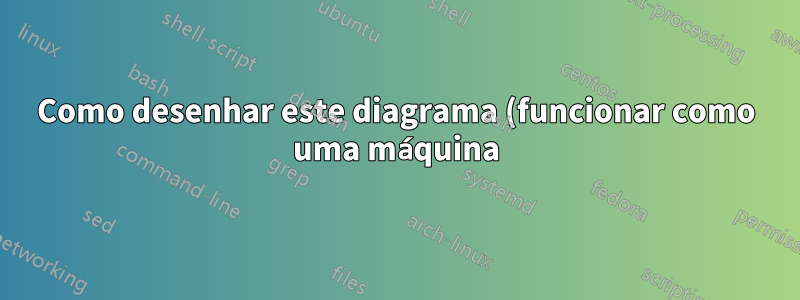%20usando%20o%20Tikz%3F.png)
Quero reproduzir o diagrama abaixo, mas não consegui encontrar o "código" para essa forma. Os diagramas de exemplo que observei mostram apenas um retângulo fechado com as setas apontando para dentro e para fora do retângulo. Qualquer ajuda é muito apreciada.

Em anexo está meu MWE atual, conforme sugerido por Jasper:
\tikzstyle{Box} = [rectangle, rounded corners, minimum width=2cm, minimum height=1.25cm, text centered, draw=blue, inner color=white, outer color=blue!30]
\tikzstyle{arrow} = [red, very thick,->,>=stealth]
\begin{center}
\begin{tikzpicture}[node distance=2.5cm]
\node (A) [Box] {\(f\)};
\node (B) [left of=A, label=below:{input}] {$x$};
\node (C) [right of=A, label=below:{output}] {$y$};
\draw [arrow] (B) -- (A);
\draw [arrow] (A) -- (C);
\end{tikzpicture}
\end{center}
Responder1
Se não houver forma, você pode criar um \pic:
\documentclass[border=10pt]{standalone}
\usepackage{tikz}
\tikzset{
pics/machine/.style={
code={
\coordinate (-in) at ({-0.5*\pgfkeysvalueof{/tikz/machine/width}},0);
\coordinate (-out) at ({0.5*\pgfkeysvalueof{/tikz/machine/width}},0);
\coordinate (-north) at (0,{0.5*\pgfkeysvalueof{/tikz/machine/height}});
\coordinate (-south) at (0,{-0.5*\pgfkeysvalueof{/tikz/machine/height}});
\path[/tikz/machine/filling]
([shift={(-0.75em,0.5em)}]-in)
-- ([shift={(0,0.25em)}]-in)
-- ([shift={(0,-5pt)}]-north -| -in)
arc[start angle=180, end angle=90, radius=5pt]
-- ([shift={(-5pt,0)}]-north -| -out)
arc[start angle=90, end angle=0, radius=5pt]
-- ([shift={(0,0.25em)}]-out)
-- ([shift={(0.75em,0.5em)}]-out)
-- ([shift={(0.75em,-0.5em)}]-out)
-- ([shift={(0,-0.25em)}]-out)
-- ([shift={(0,5pt)}]-south -| -out)
arc[start angle=360, end angle=270, radius=5pt]
-- ([shift={(5pt,0)}]-south -| -in)
arc[start angle=270, end angle=180, radius=5pt]
-- ([shift={(0,-0.25em)}]-in)
-- ([shift={(-0.75em,-0.5em)}]-in)
-- cycle;
\draw[/tikz/machine/border]
([shift={(-0.75em,0.5em)}]-in)
-- ([shift={(0,0.25em)}]-in)
-- ([shift={(0,-5pt)}]-north -| -in)
arc[start angle=180, end angle=90, radius=5pt]
-- ([shift={(-5pt,0)}]-north -| -out)
arc[start angle=90, end angle=0, radius=5pt]
-- ([shift={(0,0.25em)}]-out)
-- ([shift={(0.75em,0.5em)}]-out);
\draw[/tikz/machine/border]
([shift={(0.75em,-0.5em)}]-out)
-- ([shift={(0,-0.25em)}]-out)
-- ([shift={(0,5pt)}]-south -| -out)
arc[start angle=360, end angle=270, radius=5pt]
-- ([shift={(5pt,0)}]-south -| -in)
arc[start angle=270, end angle=180, radius=5pt]
-- ([shift={(0,-0.25em)}]-in)
-- ([shift={(-0.75em,-0.5em)}]-in);
\node (-node) at (0,0) {#1};
}
},
machine/width/.initial={3.5em},
machine/height/.initial={2em},
machine/filling/.style={
left color=cyan!50!blue!25,
right color=cyan!50!blue!25,
middle color=cyan!50!blue!10
},
machine/border/.style={
blue!50!cyan
}
}
\begin{document}
\begin{tikzpicture}
\node[label={below:{input}}] (A) at (0,0) {$x$};
\pic (B) at (2,0) {machine={$f$}};
\node[label={below:{output}}] (C) at (4,0) {$f(x)$};
\draw[red, -stealth] (A) -- (B-in);
\draw[red, -stealth] (B-out) -- (C);
\end{tikzpicture}
\end{document}



